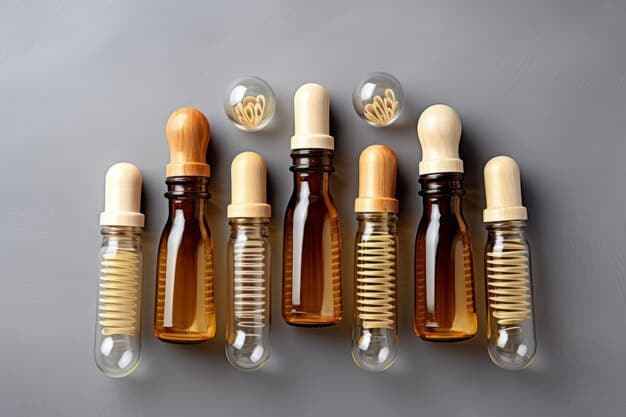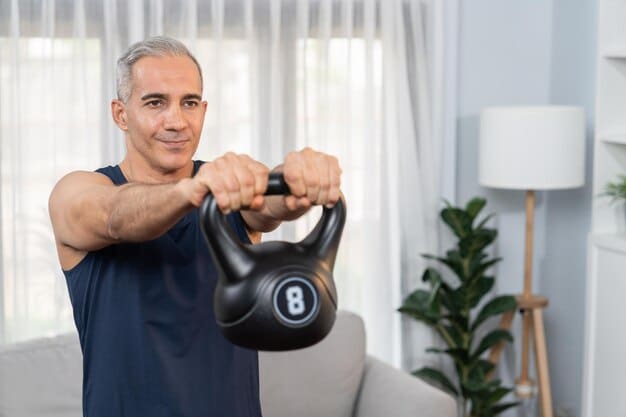Best Anti-Aging Creams for Men 2025: Real Results

In 2025, men seeking effective anti-aging solutions can find creams that deliver tangible results within eight weeks, focusing on advanced formulations designed to reduce wrinkles, improve skin elasticity, and enhance overall skin health.
As we navigate into 2025, the demand for sophisticated skincare solutions for men continues to grow, moving beyond basic hydration to target specific concerns like aging. For men seeking visible improvements, understanding which products truly perform and offer real results after 8 weeks is paramount.
The Male Skin Landscape: Why Men’s Anti-Aging Needs Differ
Men’s skin, while sharing fundamental characteristics with women’s, presents distinct differences that influence how it ages and how anti-aging products should be formulated. These variations are primarily driven by hormones, particularly testosterone, leading to different collagen structures, oil production, and overall skin thickness.
Typically, men’s skin is about 20-25% thicker than women’s, attributes to a higher collagen density, which initially provides more firmness and resilience against wrinkles. However, while men may develop signs of aging later, once they appear, they often do so more dramatically, characterized by deeper lines and more pronounced sagging, especially around the eyes and mouth.
Understanding Collagen and Elastin in Male Skin
Collagen and elastin are the foundational proteins responsible for skin’s structure and elasticity. In men, collagen breakdown might start later, but the rate of loss can be more rapid once it begins. This makes active ingredients that stimulate collagen synthesis particularly crucial for male anti-aging creams.
- Collagen Density: Higher initial density means men’s skin can appear firmer longer.
- Elastin Breakdown: While men’s skin is more robust, elastin fibers still degrade over time, leading to loss of “snap-back” ability.
- Testosterone’s Role: This hormone contributes to increased oil production, making men’s skin prone to oiliness and larger pores, which can also influence product absorption.
The Impact of Lifestyle on Men’s Skin Aging
Men often expose their skin to different environmental aggressors due to varying lifestyle habits. Shaving, for instance, can cause micro-abrasions and irritation, impacting the skin’s barrier function. Moreover, sun exposure without adequate protection is a common factor accelerating aging in men, leading to hyperpigmentation, sunspots, and increased fine lines.
Understanding these unique aspects is vital for selecting an anti-aging cream that addresses specific male skin concerns effectively. The best formulations for men in 2025 will account for larger pores, thicker skin, shaving irritation, and the particular way collagen degrades in their dermal structure, ensuring optimal penetration and efficacy.
In essence, male anti-aging skincare isn’t just about reducing wrinkles; it’s about bolstering the skin’s natural defenses, promoting cellular regeneration, and maintaining a healthy, youthful appearance that aligns with the specific physiological characteristics of men’s skin.
Key Ingredients to Look for in 2025’s Best Formulations
As science advances, so does our understanding of what genuinely works in anti-aging skincare. For 2025, the most effective formulations for men’s anti-aging creams will contain a synergy of proven ingredients, each targeting different aspects of skin rejuvenation. Identifying these components is crucial for consumers seeking measurable improvements.
Retinoids: The Gold Standard
Retinoids, especially retinol, remain at the forefront of anti-aging technology due to their unparalleled ability to accelerate cell turnover, stimulate collagen production, and reduce the appearance of fine lines and wrinkles. For men, whose skin is generally thicker, higher concentrations or more potent forms like retinaldehyde may offer more profound benefits. However, starting slow to build tolerance is always advised.
- Cell Renewal: Boosts the shedding of old skin cells, revealing fresher, younger-looking skin.
- Collagen Synthesis: Directly stimulates fibroblasts to produce more collagen, improving skin firmness.
- Texture Refinement: Helps to minimize pores and smooth overall skin texture.
Hyaluronic Acid: The Hydration Powerhouse
Often misunderstood as solely a moisturizer, hyaluronic acid (HA) is a humectant that draws moisture from the air and deeper skin layers to the surface, providing intense and lasting hydration. Adequate hydration is fundamental for plump, youthful-looking skin, helping to immediately diminish the appearance of fine lines by plumping them up. Low and high molecular weight HA are often combined for multi-level hydration.

Peptides: Building Blocks of Youth
Peptides are short chains of amino acids that act as messengers in the skin, signaling cells to perform specific functions, such as producing more collagen or repairing damaged tissue. Different types of peptides target various concerns, from firmness to wound healing, making them versatile anti-aging allies. Copper peptides, signal peptides, and neuropeptides are particularly noteworthy for their efficacy.
Beyond these, antioxidants like Vitamin C and E shield the skin from environmental damage, while Niacinamide (Vitamin B3) improves skin barrier function, reduces redness, and minimizes pore appearance. Broad-spectrum SPF is also an unnegotiable ingredient for any daily anti-aging regimen, preventing UV damage that accelerates aging.
The best anti-aging creams for men in 2025 will integrate these ingredients thoughtfully, often in innovative delivery systems that ensure maximum potency and absorption. Consumers should look for transparent ingredient lists and formulations that prioritize scientific evidence over marketing hype, promising genuine results.
Real Results After 8 Weeks: What to Expect and How to Track Progress
The promise of “real results” is exciting, but what does that truly mean within an 8-week timeframe, and how can men objectively assess their progress? Understanding the typical physiological response of the skin to active ingredients, coupled with diligent tracking, is key to managing expectations and celebrating genuine improvements.
Initial Changes (Weeks 1-4)
During the first month, the skin begins to adapt to the new cream. Users might notice subtle improvements in texture and hydration. For products containing retinoids, there could be an “adjustment period” involving mild dryness or sensitivity, which typically subsides as the skin builds tolerance. This phase is crucial for establishing a consistent routine and allowing the skin’s natural regeneration cycles to initiate.
- Enhanced Hydration: Skin feels softer and more supple due to humectants like hyaluronic acid.
- Improved Radiance: A subtle glow might appear as dead skin cells begin to shed more efficiently.
- Minor Texture Refinement: Pores may appear slightly less noticeable, and the skin surface feels smoother.
Visible Improvements (Weeks 5-8)
By the 8-week mark, the cumulative effects of consistent application become more apparent. This is when the long-term benefits of ingredients like retinoids and peptides truly begin to manifest. Users should expect to see a noticeable reduction in the depth of fine lines and wrinkles, improved skin firmness, and a more even skin tone.
The skin’s collagen production accelerates, leading to enhanced elasticity and a plumper appearance. Hyperpigmentation, such as sunspots, might start to fade, and overall skin clarity improves significantly. The skin barrier becomes stronger, making it more resilient against environmental stressors.
How to Track Progress Effectively
Objective tracking removes guesswork and provides tangible evidence of a product’s efficacy. Before starting a new cream, take “before” photos in consistent lighting and at the same angle. Repeat these photos at the 4-week and 8-week marks.
Keep a simple journal to note daily skin observations: how it feels (hydration, smoothness), any visible changes (fine lines, discoloration), and tolerability. This personal record, combined with visual evidence, offers a comprehensive picture of the cream’s performance on your unique skin. Remember, consistency is not just about daily application; it’s about giving the product enough time to work with your skin’s natural renewal process.
The 8-week period is a scientific benchmark because it generally aligns with the skin’s cellular turnover cycle. While individual results vary, this timeframe offers a realistic expectation for visible and measurable improvements in skin health and appearance, reinforcing the value of diligence in anti-aging skincare.
Application Techniques for Maximum Efficacy
Even the most advanced anti-aging cream will underperform if not applied correctly. For men, incorporating these products into a daily routine efficiently and effectively is crucial for maximizing their benefits and ensuring real results within the 8-week timeframe.
The Importance of Clean Skin
Before applying any product, ensuring the skin is thoroughly clean is paramount. A gentle facial cleanser removes impurities, excess oil, and dead skin cells, creating a clean canvas for the active ingredients to penetrate optimally. Using a cleanser specifically formulated for men’s skin can address unique concerns like oiliness and post-shave irritation.
- Morning Routine: A light cleanse to remove overnight accumulation.
- Evening Routine: A more thorough cleanse to remove pollutants and grime from the day.
- Post-Shave Care: Use non-irritating cleansers to avoid compounding any shave-related sensitivity.
Layering Products Intelligently
If your routine involves multiple skincare products (e.g., serum, moisturizer, SPF), layering them in the correct order is vital. A general rule of thumb is to apply products from the thinnest consistency to the thickest. Typically, this means:
- Cleanser: Always the first step.
- Toner (Optional): Balances skin pH and preps for absorption.
- Serum: High concentration of active ingredients, applied directly to clean skin.
- Anti-Aging Cream: Provides hydration and delivers primary anti-aging compounds.
- SPF (Morning Only): The final step in the morning routine to protect against UV damage.
Allow each product to absorb for a minute or two before applying the next, preventing pilling and ensuring proper penetration. This layering strategy ensures that each product can perform its function without interference from others.
Massage Techniques and Consistency
Applying the anti-aging cream with gentle, upward strokes can also aid in circulation and product absorption, especially on the face and neck. Use a pea-sized amount, warming it slightly between your fingertips before gently pressing and massaging it into the skin. Don’t forget the neck and jawline, as these areas often show signs of aging just as prominently as the face.
Consistency is perhaps the most significant factor. Anti-aging creams work incrementally, reinforcing skin health day by day. Skipping applications or using the product sporadically will significantly diminish its potential to deliver real results. Integrate the routine seamlessly into your morning and evening, making it a non-negotiable part of your self-care.
By adopting these application techniques, men can optimize the performance of their anti-aging creams, turning a good product into an exceptional one, and witnessing the transformative effects within the promised 8-week period.
Beyond the Cream: Lifestyle Factors for Healthy Aging Skin
While the right anti-aging cream is a powerful tool, it’s part of a larger ecosystem of factors influencing skin health and the aging process. For men, recognizing and integrating these lifestyle elements can significantly amplify the effects of their skincare routine, contributing to more profound and lasting results.
Nutrition: Fueling Skin From Within
What you eat directly impacts your skin’s vitality. A diet rich in antioxidants, healthy fats, and lean proteins provides the building blocks for healthy skin cells and protects against oxidative stress, a primary contributor to aging. Incorporate a variety of colorful fruits and vegetables, omega-3 fatty acids from fish or flaxseed, and adequate protein intake.
- Antioxidants: Berries, leafy greens, and nuts combat free radicals.
- Healthy Fats: Avocados, olive oil, and nuts support skin barrier function and hydration.
- Lean Proteins: Chicken, fish, and legumes provide amino acids for collagen production.
Hydration: The Internal Moisturizer
Drinking sufficient water throughout the day is non-negotiable for hydrated, plump skin. While topical hyaluronic acid draws moisture to the skin’s surface, internal hydration ensures cells function optimally and helps flush out toxins. Aim for at least 8 glasses of water daily, more if you’re active or in a dry climate.

Sleep: The Ultimate Regenerator
Quality sleep is when the body, including the skin, repairs and regenerates itself. During deep sleep cycles, growth hormone is released, aiding in cellular repair and collagen production. Chronic sleep deprivation can lead to dull skin, increased fine lines, and under-eye bags. Prioritize 7-9 hours of uninterrupted sleep each night.
Stress management is another critical factor. Chronic stress elevates cortisol levels, which can break down collagen and accelerate aging. Techniques like mindfulness, meditation, or regular physical activity can mitigate these effects, promoting a calm and resilient state that reflects positively on the skin.
Finally, sun protection goes beyond just SPF in your daily cream. Seeking shade, wearing protective clothing, and avoiding peak sun hours are essential habits to prevent UV damage, which is the leading external cause of premature skin aging. Embracing these holistic practices creates a powerful synergy with your anti-aging cream, ensuring your skin remains healthy, resilient, and youthful for years to come.
Addressing Common Concerns: Sensitivity, Breakouts, and Product Claims
Navigating the world of anti-aging creams can be complex, especially for men who might be new to advanced skincare. Common concerns like skin sensitivity, potential breakouts, and deciphering product claims often arise. Addressing these proactively helps ensure a positive experience and sustained adherence to the routine.
Managing Skin Sensitivity
Men’s skin, particularly after shaving, can be more prone to sensitivity. When introducing new anti-aging creams, especially those containing potent actives like retinoids, start slow. Begin with application every other night, gradually increasing frequency as your skin builds tolerance. Look for formulations labeled “hypoallergenic” or “for sensitive skin,” and avoid products with excessive fragrance or alcohol, which can be irritating.
If redness, dryness, or stinging occurs, reduce frequency or temporarily stop use. Reintroduce slowly once the skin recovers. Patch testing a new product on a small, inconspicuous area (like behind the ear or on the jawline) for a few days before full facial application can also help identify potential sensitivities.
- Patch Test: Apply a small amount to an inconspicuous area first.
- Start Slow: Introduce new products gradually into your routine.
- Look for “Sensitive Skin” Formulas: Avoid harsh ingredients known to cause irritation.
Dealing with Breakouts
Some men, especially those with oilier or acne-prone skin, might worry about anti-aging creams causing breakouts. This can happen if a product is too rich, occlusive, or contains pore-clogging ingredients. Opt for non-comedogenic formulations, often labeled “oil-free” or “gel-based,” which are less likely to block pores.
The initial phase of retinoid use can sometimes cause a temporary “purge” of existing breakouts, as cell turnover is accelerated. This is typically short-lived. If breakouts persist or worsen, consult a dermatologist to determine if the product is unsuitable for your skin type or if a different skincare approach is needed.
Ensure your skin is thoroughly cleansed before applying products, and avoid touching your face excessively throughout the day, which can transfer bacteria and oil.
Deciphering Product Claims
The skincare market is flooded with marketing jargon. When evaluating “real results” claims, look for evidence-based science. Terms like “clinically proven” or “dermatologist-tested” ideally should be backed by transparent research and consumer studies. Be wary of hyperbolic claims that promise instant or miraculous transformations.
Understand that anti-aging is a marathon, not a sprint. While visible improvements are achievable within 8 weeks, continued use and a holistic approach will yield the best long-term benefits. Focus on ingredient lists and reputable brands with a track record of effective formulations. Consulting reviews from other men with similar skin concerns can also provide valuable insights into a product’s real-world performance.
By being informed and proactive, men can confidently choose and use anti-aging creams, managing common concerns effectively and achieving the desired improvements in skin health and appearance.
The Future of Male Anti-Aging: Personalization and Tech Integration
As we advance into 2025, the landscape of male anti-aging is undergoing a transformative shift, moving beyond generic solutions towards highly personalized and technologically integrated approaches. This evolution promises even more precise and effective results, tailored to individual needs and preferences.
Personalized Formulations: DNA and Microbiome Analysis
One of the most exciting frontiers is the ability to create anti-aging creams customized to an individual’s unique genetic predispositions and skin microbiome. Companies are beginning to offer at-home test kits that analyze DNA markers related to collagen production, antioxidant capacity, and sensitivity, along with the specific bacterial balance on the skin’s surface. This data then informs the formulation of bespoke creams, optimizing ingredient concentrations and combinations for unprecedented efficacy.
- Genetic Insights: Understanding inherent predispositions to aging, sun damage, and sensitivity.
- Microbiome Balancing: Developing products that support a healthy skin bacterial flora, enhancing barrier function.
- Targeted Treatment: Delivering active ingredients in precisely calibrated amounts for specific concerns.
Smart Devices and Skincare Integration
The integration of smart devices with skincare routines is also gaining traction. Handheld devices capable of analyzing skin hydration, oil levels, and even wrinkle depth are becoming more accessible. These devices can sync with apps, providing real-time data and recommendations for product application or suggesting adjustments to skincare routines based on environmental factors or skin changes. Some advanced devices even feature microcurrents or LED therapy designed to enhance product absorption and stimulate collagen production, bringing professional-level treatments into the home.
Furthermore, the rise of AI-powered diagnostic tools promises to revolutionize how men choose anti-aging products. By uploading a selfie, AI can analyze skin concerns, recommend suitable ingredients, and even track progress over time, offering a data-driven approach to skincare selection and management.
The future of male anti-aging is not just about potent ingredients but about smarter, more informed choices driven by personal data and technological innovation. These advancements empower men to take a more proactive and precise approach to maintaining youthful, healthy skin, making the pursuit of “real results” even more attainable and tailored than ever before.
This bespoke approach means that for every man, the “best” anti-aging cream in 2025 will increasingly be the one that is uniquely designed for his skin’s specific biology and aging patterns, ensuring optimal outcomes and a truly personalized journey to healthier, more resilient skin.
| Key Point | Brief Description |
|---|---|
| 🔬 Ingredient Focus | Prioritize retinoids, hyaluronic acid, & peptides for optimal results. |
| 📊 8-Week Expectation | Visible reduction in fine lines & improved firmness by 2 months. |
| 💡 Application Tips | Cleanse, layer thin-to-thick, & apply consistently for best penetration. |
| 🌱 Holistic Approach | Combine creams with healthy diet, hydration, sleep, & sun protection. |
Frequently Asked Questions About Men’s Anti-Aging Creams
Men can generally start using anti-aging creams in their late 20s or early 30s. Even if visible signs of aging aren’t present, preventive measures like hydration and sun protection are crucial. Early adoption can help maintain skin health and delay the onset of more prominent wrinkles and fine lines, making future treatment more effective.
No, anti-aging creams, even the best ones, cannot replace professional dermatological advice. While they are highly effective for daily maintenance and visible improvement of superficial signs of aging, serious skin concerns, persistent conditions, or deep-set wrinkles may require a dermatologist’s expertise for diagnosis and advanced treatments like injectables or laser therapy.
Yes, the general rule is to apply products from thinnest to thickest consistency. Typically, this means cleansing first, followed by any serums, then your anti-aging cream, and finally, a broad-spectrum SPF in the morning. This layering ensures optimal absorption of all active ingredients and maximizes their collective benefits for your skin.
SPF is critically important for any anti-aging routine, including men’s. UV radiation from the sun is the primary external cause of premature aging, leading to wrinkles, sunspots, and loss of elasticity. Daily use of a broad-spectrum SPF 30 or higher actively prevents this damage, protecting the investment you make in your anti-aging creams and maintaining long-term skin health.
Yes, some anti-aging ingredients, particularly retinoids or certain acids, can cause temporary irritation like redness or dryness, especially when first introduced. Men’s skin, often thicker and exposed to shaving, might also be more prone to sensitivity. Starting with lower concentrations, gradually increasing use, and choosing formulas designed for sensitive skin can help minimize irritation.
Conclusion
The journey to youthful, resilient skin for men in 2025 is more accessible and effective than ever before. By understanding the unique characteristics of male skin, prioritizing formulations with scientifically-backed ingredients like retinoids, hyaluronic acid, and peptides, and committing to consistent application, men can expect to see significant and real results within just 8 weeks. Beyond the cream, integrating healthy lifestyle choices such as balanced nutrition, adequate hydration, sufficient sleep, and robust sun protection will amplify these benefits, leading to lasting improvements in skin health and appearance. The future holds even greater promise with personalized skincare and smart device integration, empowering every man to unlock his skin’s full potential for healthy aging.





